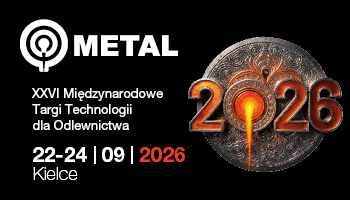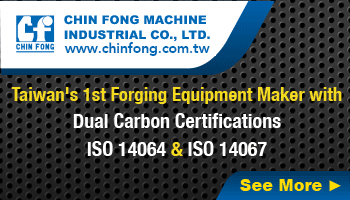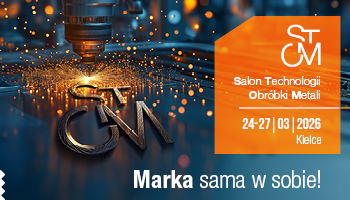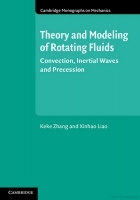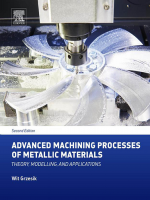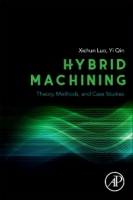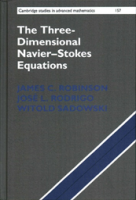Struktura geometryczna powierzchni po toczeniu wykończeniowym stali martenzytycznej AISI 630 *
Surface texture after finishing turning of AISI 630 martensitic steel
Author: Kamil Leksycki, Eugene Feldshtein
Mechanik nr 10/2018 - Obróbka skrawaniem
STRESZCZENIE: Zaprezentowano wyniki badań struktury geometrycznej powierzchni stali martenzytycznej AISI 630 po toczeniu wykończeniowym. Próby przeprowadzono w warunkach obróbki na sucho i z chłodzeniem. Badania realizowano przy zmiennych prędkościach skrawania i posuwach oraz stałej głębokości skrawania. Do realizacji eksperymentu zastosowano metodę Parameter Space Investigation (PSI), umożliwiającą prowadzenie badań przy minimalizacji liczby punktów doświadczeń. Ustalono, że przy toczeniu z chłodzeniem zmniejszają się zarówno wartości Ra, Rq, jak i intensywność wpływów prędkości skrawania i posuwu w porównaniu z obróbką na sucho. Ponadto zastosowanie niskich wartości posuwu wpływa korzystnie na wartości parametrów Ra i Rq.
SŁOWA KLUCZOWE: struktura geometryczna, toczenie wykończeniowe, stal martenzytyczna AISI 630
ABSTRACT: The surface texture of martensitic AISI 630 steel after the finishing turning is described. The tests were carried out under dry and cooling conditions. Experiments were carried out under variable cutting speeds and feeds and under a constant depth of cut. The Parameter Space Investigation (PSI) method was used that allows research with minimal experience point quantity. It was found that turning with cooling conditions reduce both Ra and Rq values and intensities of cutting speed and feed rate influence as compared out under dry conditions. The use of low feed rate values has a positive effect of the Ra and Rq parameters.
KEYWORDS: surface texture, finish turning, martensitic steel AISI 630
BIBLIOGRAFIA / BIBLIOGRAPHY:
- Dobrzański L.A. „Podstawy kształtowania struktury i właściwości materiałów metalowych”. Gliwice: Wyd. Politechniki Śląskiej, 2007.
- Ramsden J.J., Allen D.M., Stephenson D.J., Alcock J.R., Peggs G.N., Fuller G., Goch G. “The design and manufacture of biomedical surfaces”. Annals of the CIRP. 56 (2007): s. 687–711.
- Ahlhelm M., Günther P., Scheithauer U., Schwarzer E., Günther A., Slawik T., Moritz T., Michaelis A. “Innovative and novel manufacturing methods of ceramics and metal-ceramic composites for biomedical applications”. Journal of the European Ceramic Society. 36 (2016): s. 2883–2888.
- Liu G., Huang C., Zou B., Wang X., Liu Z. “Surface integrity and fatigue performance of 17-4PH stainless steel after cut-ting operations”. Surface & Coatings Technology. 307 (2016): s. 182–189.
- Liu R.L., Yan M.F. “The microstructure and properties of 17-4PH martensitic precipitation hardening stainless steel modified by plasma nitrocarburizing”. Surface & Coatings Technology. 204 (2010): s. 2251–2256.
- Liu G., Zou B., Huang C., Wang X., Wang J., Liu Z. “Tool damage and its effect on the machined surface roughness in high-speed face milling the 17-4PH stain-less steel”. Int. J. Adv. Manuf. Technol. 83 (2016): s. 257–264.
- Yanga J., Wanga X., Kang M. “Finite element simulation of surface roughness in diamond turning of spherical surfaces. Journal of Manufacturing Processes. 31 (2018): s. 768–775.
- Benardos P.G., Vosniakos G.C. “Predicting surface roughness in machining: a review”. Int J Mach Tools Manuf. 43 (2003): s. 833–844.
- Patole P.B., Kulkarni V.V. “Optimization of process parameters based on surface roughness and cutting force in MQL Turning of AISI 4340 using nano fluid”. Materials Today: Proceedings. 5 (2018): s. 104–112.
- Kiran P.C., Clement S. “Surface quality investigation of turbine blade steels for turning proces”. Measurement. 46 (2013): s. 1875–1895.
- Zawada-Tomkiewicz A. „Analiza układu obróbkowego z wykorzystaniem informacji zawartych w powierzchni obrobionej”. Mechanik. 8–9 (2013): s. 119–126.
- Zawada-Tomkiewicz A., Storch B. „Analiza struktury geometrycznej powierzchni z wykorzystaniem krzywej udziału materiału”. Mechanik. 11 (2016): s. 1728–1729.
- Zou B., Zhou H., Huang C., Xu K.,Wang J. “Tool damage and machined-surface quality using hot-pressed sintering Ti(C7N3)/WC/TaC cermet cutting inserts for high-speed turning stainless steels”. Int. J. Adv. Manuf. Technol. 79 (2015): s. 197–210.
- Statnikov R.B., Matusov J.B. “Multicriteria Analysis in Engineering”. Springer, 2002.
- Maruda R.W., Krolczyk G.M., Niesłony P., Krolczyk J.B., Legutko S. “Chip formation zone analysis during the turning of austenitic stainless steel 316L under MQCL cooling conditio”. Procedia Engineering. 149 (2016 ): s. 297–304.
- www.matweb.com (dostęp: 26.03.2018 r.).
DOI: https://doi.org/10.17814/mechanik.2018.10.146
* Artykuł recenzowany


.jpg)
